- HOME ›
- Speech delivery ›
- Vocal variety
Quick easy effective tips for vocal variety
By: Susan Dugdale
14 ways to stop your voice from being boring!
Do you know how your voice sounds in the ears of others? Not how you think it sounds, but how it actually sounds?
There is often an enormous, and often surprising, difference. We don't hear ourselves as others do and therefore, are frequently unaware of the impact of our own voice.
Our speech content, what we're saying, may be excellent. It could match our audience's needs very well but unless it's delivered in an interesting way, few people will actively listen.
That's because it's more difficult to sustain concentration when a person uses a vanilla one-flavor-fits-all voice. To be blunt, it's boring to listen to.
Good vocal variety keeps an audience engaged
What's needed is vocal variety. An appropriately expressive energized voice will keep an audience listening.
Use the quick links below to get around this very long page efficiently. You'll find 14 exercises, explanations and ongoing links if you want more information.
I've used all this material with classes and in workshops and know it's effective!
Have fun, Susan
What you'll find on this page
- What is vocal variety - an explanation of the varying elements affecting the overall quality of our voices
- The goal of a speaker - how to mix and match how we use our voices with the needs an audience and the demands of our content.
Quick easy effective tips for vocal variety
14 practical exercises to develop vocal expressiveness and flexibility
What is vocal variety?
Vocal variety refers to the way we use our voice. It is a combination of elements: pitch, tone, volume and rate.
Understanding voice pitch

To understand pitch, think of music. It has high and low notes as do people's voices.
Everyone's voice has a natural pitch.
Women's tend to be higher than men's, and everybody has a pitch range: the number of notes they habitually use. When that range is very small, the effect is monotonous.
Understanding tone of voice
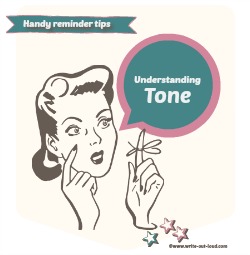
Tone refers to the emotional content carried by our voices. It is not the words themselves, but how we say them.
To speak expressively, is to fill, or energize our words appropriately.
For example: a person who puts very little energy into their speech, no matter what they are saying, is often described as being 'flat'.
By contrast someone who fills their speech to overflowing with energy is described as being 'exuberant' or 'enthusiastic'.
If you think of a word as a basket carrying its meaning or intent along, you'll get the idea. Some people put very little in their word baskets. Others stuff them so full they almost burst.
Understanding volume
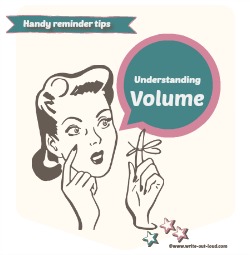
How loudly or quietly you speak is called volume.
Some people are habitually loud and others are quiet, regardless of their speech content.
The tips and exercises below will help you consciously play with your volume control.
Understanding speaking rate
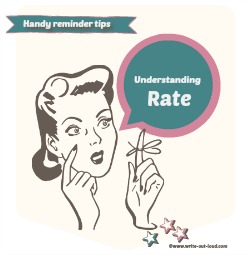
The term rate refers to speaking pace.
How fast or slow do you speak? Can you vary the rate? Do you know the effect of slowing or speeding your speech up deliberately?
Speaking rate matters because how fast or how slow you speak alters the listener's perception of your topic.
Click here for speaking rate exercises and banish mono-speed forever.
The goals of a good speaker
Every would-be competent speaker's ultimate goals are:
- to find the most appropriate expression to meet the needs of their audience.
- to match those needs with the content of their speech.
- to have a range of vocal varieties in their skillset to select the most appropriate from. This is what gives you vocal flexibility.
Quick, easy effective tips for vocal variety
Have fun with these. The more you can relax and enjoy the exercises the more you'll get out of them.
If you have access to a recorder, use it. Often what we think we're doing with our voices is very different from the reality.
A recorder doesn't lie! It will help you hear where you need to put in the work.
Three exercises for PITCH
1.One Note Charlie

Take a deep breath in and begin speaking on whatever topic you choose until you run out of breath.
It could be what is front of you in the room, or out the window, or what you had for breakfast. Anything.
Remain on the SAME note all the time.
When you have finished choose another topic and another note. It could be higher or lower and repeat.
Pay careful attention to the effect this has on you.
Notice the difference when you pitch your voice higher and then lower. You should feel a physical difference as well as an emotional one.
2.See-Saw, Up-Down
Practice swinging between your upper and lower range.
Read aloud any piece of text from a newspaper, magazine, or book.
The first sentence is up, the next is down. Continue see-sawing for at least a minute.
Now make the see-saw work faster. Read the same passage but this time it is three words up and three words down.
Continue to play with variations.
(It will sound ridiculous but it doesn't matter. You're not doing this to convey meaning. This is flexibility practice to develop your range.)
3.Pitch experiments
Say the sentences below in your high, middle and low pitch range.
Notice what happens to the intensity and the way you perceive the emotional content of the sentences. There will be a distinct variation between each.
- Her Grandmother died yesterday.
- I want a new car.
- This dinner is delicious.
- People should love their neighbors as themselves.
Seven exercises for TONE
1.The cucumber sandwich exercise
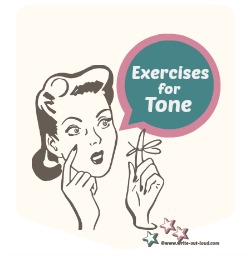
Repeat the words 'Cucumber Sandwich' in as many varying ways as you can.
For example say it angrily, happily, sadly, lovingly, despairingly, laughingly, importantly, slyly, snidely, shyly ...
This is a fantastic exercise to share with a partner. Take turn about giving each other the way to say the phrase.
Repeat until you run out of variations and remember to listen for emotional truth or believability!
2.Extend those cucumber sandwiches
Use the phrase to 'converse'. Take an emotional state and build a whole conversation around the phrase 'Cucumber Sandwich'.
For example:
Imagine you've just seen the most exciting thing. You want to share
that experience with a friend. You ring to tell them. The catch is you
must use the words 'Cucumber Sandwich' to convey your feeling and NO others.
Try consoling using 'Cucumber Sandwich' or congratulating.
Experiment with as many different ways as you can.
3.And yet more cucumber sandwich fun
This time take two opposite emotions, for example: happy - sad or, angry - contented...
Start with one emotion and gradually switch to the other.
Make sure you grade the switch. Unless we're very, very excitable emotionally, we seldom alter suddenly from one to the other.
Don't worry if you feel silly, that is, several sandwiches short of a picnic! Let go and have fun.
4.Recipe book readings
Open a recipe book at any page. Select a style* or emotion
and read aloud whatever is there. Sustain each feeling state for at
least a minute. This gives you time to get into it. Listen to yourself
to make sure you are filling those words with the appropriate emotion.
* Style?
For fun and variation read your page in the style of a newsreader, a race commentator, a preacher, Marilyn Munroe ...
5.Reading children's stories
Take a familiar children's story and read it aloud. As you do make sure your voice carries the meaning of the words.
If a scary voice is asked for, use one. If somebody is bossy, sound bossy. If someone is teasing, put a teasing tone in your voice.
If there's a beat to the words, go with it. Find and emphasize it.
This a great exercise to record. When you listen to yourself, be alert for areas to improve. Record it again with the changes.
And remember to try out your new improved reading skills with a child. Their feedback is direct and honest. You'll soon know whether they enjoy the story or not!
Click for more specific information on using characterization techniques. You'll find exercises to help you improve your expression, particularly if you are telling stories as part of a speech.
6.Watch & listen to recordings of famous speeches
For example: be inspired by Martin Luther King's 1963 speech, 'I Have a Dream'.
Learnoutloud.com has many more famous speeches in audio and video formats that you can listen to free of charge. There's Winston Churchill, Barack Obama, Nelson Mandela, Bono, Steve Jobs ...
7.Listen to audio of novels, short stories, autobiographies ...
Many of these are read by highly skilled actors. Apart from enjoying the story, you will learn a great deal about expression.
Here's a superb article from digitaltrends.com with links to 16 sources of free audio books.
Four exercises for VOLUME
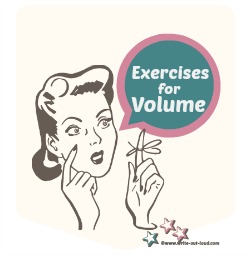
Use the following exercises if you decide not to use a microphone and want to project your voice naturally.
The skill involved with getting louder (or softer) is to maintain tone and pitch while altering the sound level. Many people lose them both, particularly when they get louder.
Shouting may guarantee you get heard but it doesn't usually mean heard with pleasure. And the other down-side to shouting is straining your voice.
Good breath control is fundamental to raising the volume while maintaining tone and pitch. Begin with the first exercise before moving on to the others.
1.Practice breathing using your diaphragm
Stand
in front of a mirror.
Make sure your feet are a comfortable shoulder
width apart.
Pull yourself up straight and let your head sit square on
your neck.
Place one hand on your stomach.
Breathe in through your nose.
You should feel
your stomach rising and then breathe out. This time your stomach falls.
Watch your shoulders. If they rise and fall noticeably you are most likely breathing off the top of your lungs.Try until you can feel a definite rise and fall of your stomach while keeping relaxed.
Click this link for more breathing exercises. These will help with any anxiety issues you may have too.
2.Distancing technique for voice projection
Maintain the breathing technique outlined above while adding voice.
While watching yourself to check for tension, (tightening of muscles), practice greeting yourself at ever increasing distances from a mirror.
If your room is small, do the exercise outside and imagine the mirror. It remains in the same place all the time.
Start with 'Hello Bob', (or what ever your name is), right up close to the mirror. Then take two steps back and repeat the greeting. Now take more steps back, repeat the greeting, and so on.
If you feel any tension in your throat or chest from forcing the sound, stop. Breathe and begin again.
It helps to imagine the sound arcing through the air, in a concentrated focused stream to reach its target. The further away you get, the more control you need to have over the outflow of air carrying your words.
When you think you have a neutral 'Hello Bob' mastered, add emotional color. Say hello to yourself nastily, lovingly, sweetly ... while keeping relaxed.
3.Laugh out loud
Stand in front of your mirror breathing easily. On your out breath begin a series of 'Ha-ha-ha-ha's' until all your breath is used.
Take an in breath and start again. Vary your laughter. Make it louder, make it quiet and then build it up again. Repeat until you are laughing loudly and easily without any strain.
4.Read out loud
Make sure
your stance and breathing is good. Then pin point a place at the far end of
your room to talk to. For example, I often used a painting on the back wall of
the rehearsal hall.
Read aloud from your text, making sure you maintain your relaxed state while using as much vocal variety as you can.
A good way to test you're working as you should is to do this exercise with a partner. Have them stand at the far end of the room you're practicing in. Give instructions to give you feedback on clarity, variety and pitch.
If you find yourself rising in pitch, check your breathing. When we tense, we strain the throat and when that happens our vocal chords are restricted. The result is we force the pitch up and limit the range or color we can put into our words.
If you haven't got a partner available, be very aware of the changes in your body as you tighten. You will feel the strain in your upper chest and throat. In addition your shoulders will lift and you will run yourself out of breath easily.
That's it!
Have
fun practicing your quick easy effective tips for vocal variety.
Aim for control over one or two aspects at a time. Remember it's not so much the length of time you practice but the regularity. Ten minutes once a day over several weeks is more effective than an intense hour long session once in a blue moon.
Related useful pages:
Pages covering other vocal aspects of delivery:
- Diction exercises: tongue twisters for clear articulation
- Pronunciation: what is proper? Why is it important?
- Pausing: how to use the power of silence effectively

About the Author: Susan Dugdale, founder of write-out-loud.com, is a qualified teacher of English and drama with over 40 years of experience. Drawing on her professional expertise and her personal journey from shyness to confidence, Susan creates practical, real-world resources to help people find their voice and speak with power.





